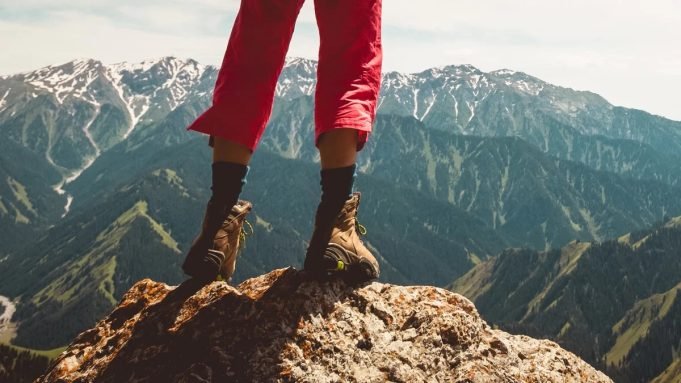A decent pair of hiking boots is the most essential piece of equipment for a successful hike. If your feet are comfortable, they can transport you to some amazing places. But if you’re wandering all day in poorly-fitting boots, you won’t enjoy yourself. Isn’t having fun the whole purpose of hiking? Check out this guide to some of the year’s finest hiking boots if you’re in the market for new hiking footwear. However, how should hiking boots fit? An excellent pair of boots that do not fit properly will not be comfortable. We’ll tell you exactly how these boots should fit.
Hiking Boots Sizing
how should hiking boots fit? Hiking boots (and hiking shoes) should be snug in the heel (minimal lifting or slippage) and comfortable in the forefoot (not tight), with enough toe box space to wiggle your toes.
This final point is essential. As a general rule, your longest toe should have at least a half-inch of space between it and the extremity of the shoe. (This is roughly the breadth of your index finger.) This additional capacity will
- Allow for swollen feet, which are common on difficult or lengthy treks.
- Allow your toes to naturally spread for a stronger base.
- On steep descents, prevent your toes from reaching the end of your boots. This is a common cause of toe injuries and toenail loss.
Typically, your hiking shoe size will be a half or full size larger than your casual or formal shoe size. However, there is more to fitting than sizing up. In the end, you want to discover the hiking boot or hiking shoe that best fits your foot’s size and shape. Here are instructions for fitting your own hiking footwear or shoes.
How Should Hiking Boots Fit?
Fit is the most essential consideration when purchasing new hiking boots. As your feet will be sustaining your body weight and your pack for miles upon miles, you should ensure that they are comfortable. Start by trying on a few pairs of high-quality trail shoes or hiking footwear.
Once your foot is securely within the shoe, transfer your weight to the forefoot. Between your heel and the back of the shoe, you should easily be able to place your index finger. If you cannot, your descent will result in bruised digits.
Now evaluate the width. At the widest region of the forefoot, the shoe or boot should fit snugly but not tightly. There should be no discomfort or pressure at the heel or on the ankle bones.
For the best hiking boot fit, follow these tips:
Fit over features – A well-fitting boot with limited features is always preferable to a poorly-fitting boot with extras. The correct fit holds your foot securely without constriction or “hot spots” (areas where your shoe irritates your foot).
Time of day – Feet expand as the day progresses, much like they would on the trail. Whenever possible, purchase hiking footwear in the afternoon, when your feet are at their largest.
Shop in-person – Finding the perfect fit is best accomplished in a store, not online. A good retailer will have a rocky incline slope for you to experience how each pair of boots will feel on the trail.
Take your time – high-quality boots are expensive, and once you’ve worn them outside, they’re ruined. Take your time while purchasing hiking footwear.
Do your research – Investigating your options online prior to trying them on in a store can save time.
Home try-on – Spend time indoors in your new hiking boots before hitting the path. It’s an excellent method for confirming the correct decision before it’s too late.
Add arch support – The generic factory insoles in your new footwear lack the support that even light hikers require. Adding arch support inserts to your shoes will help keep your feet comfortable and healthy as you log miles. Always purchase hiking boots that cater to flat feet if required
Frequently Asked Questions
Should hiking boots be loose or tight?
The fit of hiking boots should be snug everywhere but tight nowhere, with flexibility for toe movement.
Is it OK to wear hiking boots that are too big?
This is a leading cause of foot discomfort. If your footwear is too large, your feet may glide around inside your boots, causing friction and blisters. This can be particularly problematic when walking or standing for extended periods.
Is it better for hiking boots to be bigger or smaller?
During hiking, the feet have a tendency to expand, so it is advisable to wear shoes or boots that are slightly larger than necessary. Purchase your hiking footwear a half-size larger than you believe you need.
How do I know if my hiking boots are too big?
Your heel should not move excessively while walking. If your heel moves while walking, your hiking footwear is too large. Your foot should remain stationary while walking. Ensure that you walk at various speeds to avoid experiencing discomfort.



![What to Wear When Hiking in Summer [Stay Cool and Comfy] What to Wear When Hiking in Summer](https://tourinplanet.com/wp-content/uploads/2023/10/What-to-Wear-When-Hiking-in-Summer-238x178.jpg)






![What Does Aviates Stand for in Aviation? [The Art of Flying] Aviates](https://tourinplanet.com/wp-content/uploads/2024/07/Aviates-100x75.jpg)














![25 Best Peruvian Foods You Must Try In Peru [With Recipes] Peruvian Food](https://tourinplanet.com/wp-content/uploads/2024/07/Peruvian-Food-100x75.jpg)


